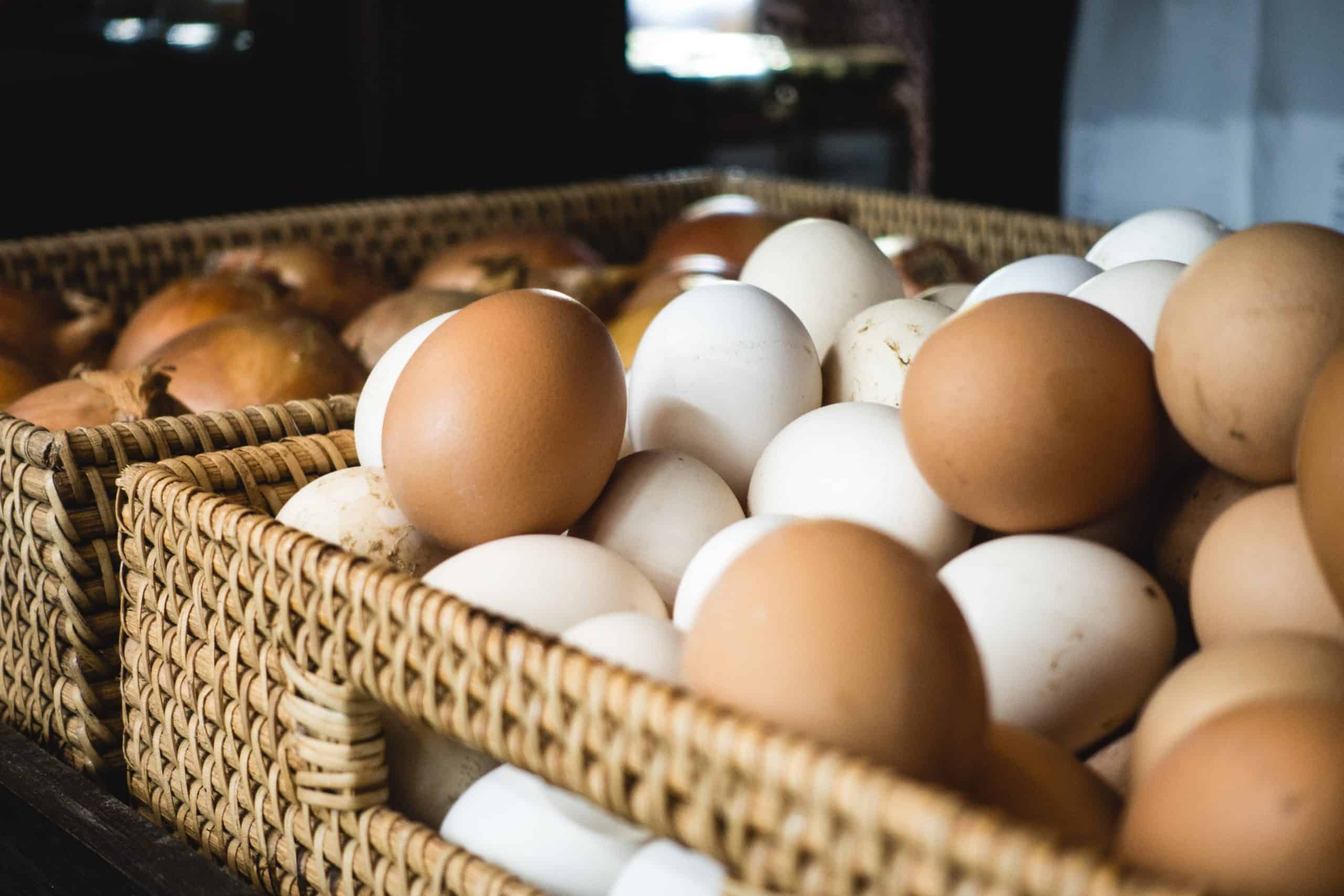Knowing how to safely preserve and store eggs correctly is key to ensuring food safety, extending shelf life, and for sellers, increasing profit. Whether you’re managing eggs at home or for a small business, proper handling prevents the spoilage of eggs. This guide will walk you through the safest, most effective methods for egg storage, based on expert guidance.
Quick Guide: 4 Rules for Storing Eggs Safely
For the best quality and safety, always follow these four guidelines from the USDA: Shell Eggs from Farm to Table:
- Refrigerate Promptly: Store eggs at or below a 40°F refrigerator temperature.
- Follow the Time Rule: Never leave eggs at room temperature for more than two hours (the 2-hour rule). This window shrinks to just 1-hour above 90°F.
- Keep Them in the Carton: The best material to store eggs in is their original carton, placed in the coldest part of the fridge (not the door).
- Use Hard-Cooked Eggs Quickly: Eat refrigerated hard-cooked eggs within one week.
How We Researched This To ensure our guidance is accurate and prioritizes your safety, we based this article on information from leading food safety authorities. Our primary sources include the USDA FSIS, the U.S. FDA (including FDA 21 CFR 115.50 and FDA 21 CFR 118), the National Center for Home Food Preservation (University of Georgia), Penn State Extension, and Utah State University Extension.
Last reviewed on September 29, 2025.
6 Ways to Preserve Eggs (and When to Use Each Method)
There are several methods of preservation of eggs, each with its own purpose and shelf life. Here are the most common and safest options, from everyday refrigeration to long-term freezing.
Here is a quick comparison of the shelf life you can expect from each method:
| Method | Storage Condition | Best Quality Timeline |
|---|---|---|
| Fresh Shell Eggs | Refrigerated (≤40°F / 4°C) | 3 to 5 weeks |
| Hard-Cooked Eggs | Refrigerated | Within 1 week |
| Frozen Eggs (out of shell) | Frozen (≤0°F / -18°C) | Up to 1 year |
| Pickled Eggs | Refrigerated | 3 to 4 months |
| Dried Egg Products | Cool, dry place (unopened) | Per manufacturer’s label |
Source: USDA FSIS, NCHFP
Refrigeration: The Best Way to Store Fresh Eggs
Refrigeration is the simplest and most effective way to keep eggs fresh and safe. It is the gold standard for preserving egg quality and preventing foodborne illness.
- What it does: Cold temperatures dramatically slow down the growth of bacteria, like Salmonella Enteritidis, a risk that is best managed on-farm with a good biosecurity plan. The cold also helps eggs retain the moisture and carbon dioxide that keep them fresh.
- How to do it safely: According to the USDA: Shell Eggs from Farm to Table, you should place the egg carton in the coldest part of your refrigerator—typically a middle or lower shelf towards the back. Avoid the refrigerator door, where temperatures fluctuate each time it’s opened, which can degrade quality faster. The ideal temperature is 40°F (4°C) or slightly below.
- Shelf-life impact: Fresh eggs can last for about 3 to 5 weeks in the refrigerator without a significant loss in quality.
- When to use: This is the standard, everyday method for anyone who buys or raises eggs for regular consumption.
Washed vs. Unwashed Farm Eggs
In the U.S., refrigerate all eggs promptly and keep them cold. Cold eggs should not be left out; condensation can pull bacteria inside. In the EU, Class A eggs are typically not washed, leaving the protective cuticle—a natural protective layer that relies on good nutrition, including whether chickens get enough grit or oyster shells—intact. This is why you may see unrefrigerated eggs there, as their marketing standards are different.
Storing Hard-Cooked Eggs
Once cooked, eggs become more perishable. Store hard-cooked eggs, peeled or unpeeled, in an airtight container in the refrigerator and consume them within one week. For best results, leave the shells on until you are ready to eat them, as the shell provides a protective barrier.
Freezing Eggs for Long-Term Storage
Freezing is the best way to freeze eggs for long term storage, for up to a year. It’s a perfect solution for a surplus of eggs from your backyard chickens or a sale at the grocery store.
- What it does: Freezing completely stops microbial growth while frozen; once thawed, handle as perishable and cook. It also preserves the eggs’ nutritional value for an extended period. The texture of the whites remains largely unchanged, while yolks can become thick and gelatinous if not prepared correctly.
- How to do it safely: The NCHFP: Freezing eggs (tested method) provides clear instructions. Never freeze eggs in their shells, as the liquid will expand and crack them.
- Whole Eggs: Crack eggs into a bowl and gently whisk until the yolks and whites are just combined. Avoid whipping in too much air.
- Egg Whites: Whites can be frozen on their own without any additives. You can freeze them individually in ice cube trays for easy portioning.
- Egg Yolks: Yolks require stabilizers to prevent them from becoming gummy. For every 4 egg yolks, mix in either 1/8 teaspoon of salt (for savory dishes) or 1 ½ teaspoons of sugar or corn syrup (for baking).
- Shelf-life impact: According to the USDA: Egg products & freezing quality window, frozen eggs are best used within one year for optimal quality.
- When to use: Use this method when you have more fresh eggs than you can use within a few weeks.
How to Thaw and Use Frozen Eggs
Thaw frozen eggs overnight in the refrigerator or under cold running water. Use them as soon as they are thawed in dishes that will be fully cooked, like scrambles, frittatas, or baked goods.
- Helpful conversion: 3 tablespoons of thawed whole egg mixture equals one large fresh egg.
Pickled Eggs (Refrigerated Only)
Pickling is a traditional method that infuses hard-cooked eggs with a tangy, savory flavor. However, modern safety guidelines are very strict.
- What it does: A high-acid brine (vinegar solution) preserves peeled, hard-cooked eggs and adds flavor.
- How to do it safely: Always store pickled eggs in the refrigerator. The CDC: Botulism case — home pickled eggs (1997) has documented cases of botulism from homemade pickled eggs stored at room temperature. The NCHFP: Pickled eggs — refrigerated only guidance is clear: never attempt to “can” pickled eggs in a water bath at home. Use a tested recipe from a university extension like Penn State Extension, with vinegar that has at least 5% acidity.
- Shelf-life impact: Refrigerated pickled eggs can last for a few months. Use within 3–4 months for best quality; keep refrigerated the entire time.
- When to use: This method is for creating a flavorful snack or appetizer, not for long-term pantry storage.
Dehydrated and Dried Egg Products (Commercial and Home Use)
Dried eggs, or pasteurized dried egg products, are a lightweight, shelf-stable alternative to fresh eggs that requires no refrigeration.
- What it does: Removing all moisture through dehydration makes it impossible for bacteria to grow, resulting in a product with a very long shelf life.
- How to do it safely: Skip home-dehydrating raw eggs; use commercially pasteurized dried egg products. Once reconstituted, they should be used immediately or the same day under refrigeration, per USDA guidance on egg products.
- Shelf-life impact: Commercially dried eggs can last for years when stored in a cool, dark, and dry place.
- When to use: Ideal for long-term food storage, emergency preparedness kits, backpacking, and baking.
Oiling/Coating Eggs to Reduce Moisture Loss
Oiling is an age-old technique used to extend the quality of fresh, unwashed eggs.
- What it does: An eggshell has thousands of tiny pores. Coating eggs with a thin layer of food-grade mineral oil or other edible oil seals these pores, which significantly reduces moisture and carbon dioxide loss. This helps maintain the egg’s internal quality (measured in Haugh unit).
- How to do it safely: While oiling helps preserve quality, it is not a substitute for refrigeration in the U.S. commercial system. Think of it as a quality enhancer, not a safety guarantee. Oiled eggs must still be kept cold to reliably prevent bacterial growth.
- Shelf-life impact: Can extend the high-quality window of refrigerated eggs by several weeks.
- When to use: Useful for those with a large supply of fresh, unwashed farm eggs to help maintain their freshness longer under refrigeration.
Controlled Cold Chain for Commercial Storage and Sale
For anyone who wants to preserve eggs for sale, especially those raising layers for egg production, maintaining a strict cold chain is the most critical factor for ensuring safety, quality, and profit.
- What it does: Keeping eggs at a consistent, cool temperature minimizes bacterial growth, slows quality degradation, and ensures you can comply with food safety regulations.
- How to do it safely: The FDA requires that shell eggs be held and transported at a 45°F ambient retail temperature or less, as outlined in 21 CFR 115.50: Retail refrigeration at 45°F. This rule applies from the farm all the way to the retail display case. Under the FDA Egg Safety Rule: 36‑hour refrigeration and 45°F transport, producers with ≥3,000 hens must refrigerate starting 36 hours after lay and hold/transport at ≤45°F ambient.
- Shelf-life impact: A disciplined cold chain is the single best way to maximize the shelf-life of eggs for sale and is a core part of your business plan.
- When to use: This is a non-negotiable legal and ethical requirement for anyone involved in the commercial sale of eggs.
In summary, the best preservation method depends on your timeline. Refrigeration is for daily use, while freezing is for long-term storage. Now that we understand these methods, let’s address the common question of how to handle eggs when refrigeration isn’t an option.
How to Preserve Eggs Without Refrigeration (and Why It’s Not Recommended in the U.S.)
In the United States, official guidance from the USDA is clear: learning how to preserve eggs without refrigeration is not recommended for more than two hours. The primary concern is the growth of Salmonella Enteritidis, bacteria that can be present inside a perfectly normal-looking egg.
When eggs are left at room temperature, two things happen: bacteria can multiply rapidly, and temperature fluctuations can cause the shell to “sweat.” This condensation can make it easier for bacteria on the shell’s surface to be pulled inside through the pores.
Why is it Different in Other Countries?
You may have traveled to Europe or other parts of the world and seen eggs sold on the shelf. This is typically because their processing standards are different. In many countries, eggs are not washed, leaving the protective cuticle intact. This natural barrier provides enough protection for short-term room temperature storage. In the U.S., the commercial washing process makes refrigeration essential for safety.
The key takeaway is that in the U.S., refrigeration is a must due to how eggs are processed. This naturally leads to the next question: how long do you really have before an unrefrigerated egg becomes unsafe?
How Long Do Eggs Last Without Refrigeration?
According to the USDA FSIS, fresh shell eggs should not be left at room temperature for more than two hours. This is known as the “2-hour rule.” This timeframe applies to what the USDA: The “Danger Zone” and the 2‑hour rule calls the “danger zone” for bacterial growth. If the ambient temperature is high, such as above 90°F (32°C)—a common occurrence during hot spells like the Harmattan season—this safety window shrinks to just one hour. Learning [how to manage poultry in Harmattan](https://www.google.com/search?q=https://chickenstarter.com/how-to-manage- poultry-in-harmattan/) is therefore crucial for both flock health and egg safety.
How to Tell if an Egg Has Gone Bad
While time and temperature are the best guides for safety, your senses are the ultimate test for spoilage. An egg’s quality is often a direct reflection of the hen’s well-being, so performing a regular chicken health check can help you catch issues before they impact egg production.
- The Smell Test (Most Reliable): A spoiled egg will have a distinct, foul, sulfur-like odor. You will know it the moment you crack it. If it smells bad, discard it immediately. Never taste an egg to see if it’s spoiled.
- The Visual Test: Before cracking, check that the shell is not slimy, cracked, or powdery, which can indicate mold. After cracking, a spoiled egg white may appear pinkish, greenish, or iridescent, which is a sign of bacterial contamination.
- The Float Test (Age, Not Spoilage): You can use the “float test” to gauge the age of an egg, but as the USDA notes, it is not a test for safety.
- How it works: Place an egg in a glass of water. A fresh egg will sink and lie on its side. An older egg will stand on its end or float, as the air cell inside has grown larger over time.
- The takeaway: A floating egg is old and has lost quality, but it isn’t necessarily spoiled. The float test is about age/quality, not safety; always crack and smell.
Relying on the 2-hour rule is your safest bet, and always trust your senses to detect spoilage. With these modern safety rules in mind, it’s worth looking at historical methods like water glassing eggs to understand why they are no longer recommended.
Water Glassing Eggs: Not Recommended Today
Water glassing eggs is a historical preservation method that is not recommended by food safety experts today. This technique involves submerging fresh, unwashed eggs in a solution of slaked lime (calcium hydroxide) or sodium silicate. According to USU Extension: Why water‑glassing isn’t recommended today, the primary rationale for avoiding it is the unverified risk of bacterial survival and the availability of safer, tested methods like freezing.
While it was used before the widespread availability of refrigeration, it is not a scientifically validated practice by modern standards. With proven alternatives, there is no need to take this risk.
Advanced & Alternative Preservation Methods
For culinary enthusiasts, there are other, more specialized techniques:
- Salt-Curing Yolks: This gourmet method involves burying egg yolks in a mixture of salt and sugar for several days until they become firm and translucent. Once rinsed and dried, they can be grated over pasta, salads, or soups for a rich, savory flavor, similar to a hard cheese. These must be stored in the refrigerator.
- Freeze-Drying: Commercially freeze-dried eggs offer very long shelf life per label. For home freeze-drying, note that freezing or freeze-drying do not kill Salmonella; treat rehydrated eggs as raw and cook thoroughly, a caution echoed by Utah State University Extension.
While historical methods are interesting, sticking to modern, science-backed preservation is crucial for safety. For those selling eggs, this focus on safety and quality becomes a business imperative, governed by specific commercial standards.
How to Prep Eggs for Sale: Grading, Labeling, and Handling
If you plan to store eggs commercially, moving beyond simple storage to proper commercial prep is vital for public health and profitability.
Key Regulatory Requirements
Under the FDA’s Egg Safety Rule, producers must adhere to strict refrigeration and testing measures to control for Salmonella. This includes maintaining an ambient temperature of 45°F (7.2°C) or lower and labeling cartons with safe-handling instructions as detailed in the FDA guide: safe‑handling label + 45°F retail storage.
Practical Steps for Small Producers
- Cleaning: Clean soiled eggs carefully. The best way to start is by ensuring you have clean and well-designed nesting boxes to minimize dirt in the first place. Dry cleaning with a brush or sandpaper is often preferred over washing to keep the bloom intact if local regulations permit. If you wash eggs, use water that is at least 20°F warmer than the egg and refrigerate immediately.
- Candling and Grading:Egg grading involves shining a bright light through the egg to inspect the interior for defects. This helps you grade eggs by quality, with Grade AA being the highest, according to the USDA’s official egg grading standards. Consistent grading builds customer trust.
- Grade AA: The yolk is firm and high, whites are thick, and the air cell is small. The highest quality.
- Grade A: The yolk is round and upstanding, and the whites are still mostly thick.
- Grade B: The yolk is flattened, and the whites are thin. These are often used for liquid or dried egg products.
- Packaging: Use new, clean cartons. Label them with your farm name, the packing date, and the required 21 CFR 101.17(h): Shell egg safe‑handling statement.
- Stock Rotation: Always use a “first-in, first-out” (FIFO) system to ensure you sell your oldest (but still fresh) eggs first.
For sellers, following these commercial guidelines is non-negotiable for running a safe and successful business. Ultimately, preventing spoilage for both home and commercial use comes down to a few key, disciplined practices.
How Do You Increase the Shelf-Life of Eggs? (Checklist)
To reduce spoilage, protect your profits, and increase the shelf-life of eggs, a proactive strategy is essential. It’s about more than just a cold fridge; it’s a disciplined process based on core food safety principles.
- Master Temperature Control: The cold chain is your most powerful tool. Maximizing sellable inventory starts with knowing how many eggs your layers can produce and ensuring none are lost to spoilage. Use thermometers to monitor storage areas and transport coolers, keeping them at or below the 45°F (7.2°C) commercial standard or the 40°F (4°C) home standard.
- Proper Handling and Storage Practices: Always handle eggs gently to avoid hairline cracks that can let in bacteria. Store them in their original carton, which protects them from absorbing odors and from physical damage. The carton also helps maintain the proper humidity.
- Staff Training is Key: If you have a team, ensure every member understands the importance of the cold chain and the 2-hour rule. A single mistake—like leaving a flat of eggs on a loading dock for too long—can compromise safety and lead to financial loss. Create simple checklists to reinforce these rules.
Mastering these core principles will ensure your eggs remain safe and high-quality for as long as possible. We will now conclude by answering some of the most frequently asked questions on this topic.
FAQ
How to preserve eggs for years?
There is no safe home method to preserve eggs for years. For long-term storage, use freezing (out of the shell) or purchase commercially pasteurized dried or freeze-dried products. Always cook any reconstituted egg products thoroughly.
What is the best preservative for eggs?
The best preservative for eggs isn’t an additive; it’s temperature control. Refrigeration is the most important step for safety and freshness. While oiling can help maintain quality, it does not replace the need for cold storage to prevent bacterial growth.
What oil is used to preserve eggs?
Food-grade mineral oil or other edible oils are used to coat eggshells. This is a quality-enhancement technique that slows moisture loss, not a safety method. Oiled eggs still require refrigeration.
What are the 4 guidelines to follow when storing eggs?
The four primary guidelines are: 1) Refrigerate at 40°F (4°C) or below; 2) Keep them in the original carton; 3) Don’t leave them at room temperature for more than 2 hours; and 4) Use hard-cooked eggs within 1 week.
What is the best way to store fresh eggs?
The best way to store fresh eggs is in their original carton in the coldest part of the refrigerator (not the door), at a temperature of 40°F (4°C) or below.
What are the methods of preservation of eggs?
The main safe methods of preservation of eggs are refrigeration, freezing (out of the shell), and pickling (refrigerated only). Commercially produced dried egg products are another option. Oiling is a quality enhancer used alongside refrigeration.
How to freeze eggs for long-term storage?
To freeze eggs for long-term storage, crack them out of their shells and whisk them gently. Stabilize yolks with a small amount of salt or sugar. Freeze in airtight containers or ice cube trays for up to a year. Remember that 3 tablespoons of thawed egg mixture equals about one large fresh egg.
What is the best material to store eggs in?
The best material to store eggs in is a new, clean cardboard carton. It protects the eggs from damage and from absorbing strong odors from other foods in the refrigerator. Avoid storing them in the plastic trays built into many refrigerator doors.
Conclusion: Storing Eggs with Confidence
Preserving and storing eggs doesn’t have to be complicated. By understanding the core principles of temperature control and food safety, you can confidently handle eggs to maximize their freshness, extend their shelf life, and ensure they are safe to eat. Whether you are managing eggs for your family’s kitchen or for a small business, the key is to prioritize safety first.
For daily use, nothing beats the simplicity and effectiveness of refrigeration. For long-term needs, freezing offers a reliable way to save a surplus. By following the guidance from trusted sources like the USDA and FDA, and always trusting your senses, you can reduce waste, and for sellers, protect your profit and reputation. Armed with this knowledge, you are now well-equipped to get the most out of every egg.

Oladepo Babatunde is the founder of ChickenStarter.com. He is a backyard chicken keeper and educator who specializes in helping beginners raise healthy flocks, particularly in warm climates. His expertise comes from years of hands-on experience building coops, treating common chicken ailments, and solving flock management issues. His own happy hens are a testament to his methods, laying 25-30 eggs weekly.



